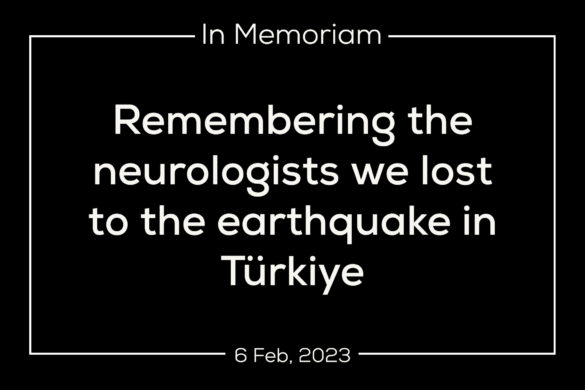by Thomas Jenkins
For October 2019, we have selected: Nelson et al., Limbic-predominant age-related TDP-43 encephalopathy (LATE): consensus working group report Brain 2019; 142: 1503-27.
This month’s selected paper is a working group report that addresses a recently described disorder, limbic-predominant age-related TDP-43 encephalopathy (LATE), which is emerging as an important cause of cognitive impairment in the elderly. The group make recommendations for standardised neuropathological evaluation and identify research avenues to better understand this evolving new disease phenotype.
It is increasingly recognised that pathological findings in people with cognitive impairment often extend beyond Alzheimer-disease neuropathological change, multiple pathologies are common, and may help explain observed discordance between clinical and histological findings. The first report of hippocampal sclerosis in patients lacking typical Alzheimer changes, such as amyloid plaques, was in 1994, from a case series of 13 elderly patients with dementia. This was published prior to the discovery of phosphorylated TDP-43, which occurred in 2006, and was first identified in ubiquitinylated inclusions in patients with amyotrophic lateral sclerosis (ALS) and frontotemporal dementia (FTD). TDP-43 is encoded by the TARDBP gene, and regulates aspects of both gene transcription and translation. In health, TDP-43 is expressed in most cell types, is predominantly non-phosphorylated and located within the cell nuclei. In disease states, TDP-43 is phosphorylated and mislocated to the cytoplasm. TDP-43 proteinopathy was subsequently identified in people older than 80 years who had no clinical features of ALS or FTD. These patients had hippocampal sclerosis, like those in the 1994 case series, and TDP-43 proteinopathy is now recognised to be associated with a progressive amnestic syndrome distinct from Alzheimer’s disease.
The pathological hallmark of LATE is mislocalised and phosphorylated TDP-43 within limbic structures, and changes have also been found in the olfactory bulb, neocortex, basal ganglia and occasionally the brainstem. Neuronal loss, astrogliosis and atrophy occur. Hippocampal sclerosis is unilateral in 40-50% of cases and is non-specific for disease aetiology; demonstration of TDP-43 pathology is necessary for histological diagnosis of LATE and is generally bilateral. In order to better understand this emerging phenotype, the authors recommend that TDP-43 immunohistochemistry is performed at autopsy in all older subjects and that, as a minimum, the amygdala, mid-level hippocampus and middle frontal gyrus are assessed (which tend to be involved sequentially in that order and form the basis of staging protocols).
Radiologically, hippocampal atrophy may appear more marked in LATE than Alzheimer’s disease. Atrophy in inferior frontal, anterior temporal and insular cortices has been observed. Clinically, the condition affects especially the very elderly. An amnestic cognitive syndrome is typical at onset, but can evolve into a multi-domain dementia. Delayed recall of word lists (a hippocampal-dependent neuropsychological function) with relatively preserved verbal fluency (cortically-dependent) is associated with LATE, and this pattern differs from Alzheimer’s disease and FTD. Behavioural features such as agitation and aggression have been reported. TDP-43 pathological change in the absence of clinical cognitive change is recognised.
Five genes have been found to confer risk of developing LATE pathological changes: granulin and TMEM106B (which are also associated with FTD), APOE (which is also associated with Alzheimer’s disease), ABCC9 and KCNMB2. These associations suggest some commonality of pathogenetic mechanisms in neurodegenerative disease.
LATE appears quite common, with pathological features identified in approximately 20% of people over the age of 80 in autopsy series. Comorbidity with Alzheimer’s disease is frequent and appears to be associated with a more rapidly progressive disease course. LATE is likely to represent a significant public health burden.
Therefore, further research is needed. Additional epidemiological, clinical, pathological, neuroimaging and genetic studies are required to better characterise phenotypes and public health impact. Animal models and basic science studies to help decipher disease mechanisms are necessary. No biomarkers currently exist in LATE and this is another important area-of-need
Prof Reinhold Schmidt, Medical University of Graz commented: “The working group has to be complimented for proposing a new terminology for a clinical-pathological entity that is long recognized and has initially been termed hippocampal sclerosis. It was known from many sources that hippocampal sclerosis most commonly relates to a TDP-43 proteinopathy and occurs often in dementia cases of the oldest-old. The merit of this paper is that the authors now provide a consensus-based nomenclature. The new name is limbic-predominant age-related TDP-43 encephalopathy (LATE) and guidance is provided for the autopsy evaluation and staging of LATE neuropathological change (LATE-NC). I am certain that this article will foster much needed research on this entity as diagnostic tools, such as biofluid or neuroimaging biomarkers, for ante-mortem detection are currently lacking.”













